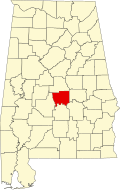History
William Thompson, [3] the first settler in what is now Autaugaville arrived around 1820 and built a gristmill and sawmill on Swift Creek, about three miles upriver from the Alabama River. One source says that the town incorporated in 1839, but another cites 1907. A cotton mill opened in 1849 on the banks of Swift Creek, and following upon the model of industrialist Daniel Pratt, the owner constructed housing for its employees, expanding the town. It grew further when many citizens from nearby Vernon relocated here to escape the floods and diseases to which that town was prone. By 1851, the town had a population of 351 and claimed four stores, two churches, and two schools.
Additional businesses opened during this period, including a cloth factory, a buggy and wagon factory, and a gristmill, making it a thriving manufacturing center. The downtown area was seriously damaged by a fire in 1853, but quickly rebuilt. The town's first and only newspaper, the Autauga Citizen, also began publication in 1853, existing until 1873.
The Civil War and Reconstruction resulted in the closing of the town's factories, including the cotton factory, which saw its shipments seized by the U.S. government. The war and its aftermath essentially ended Autaugaville's status as a manufacturing center. The town incorporated in 1907, and the Alabama Central Railroad built a branch through town in 1911. At least one of several lumber mills operated periodically until the 1930s. In 1936, an Alabama Forestry Commission nursery opened near town. Crystal Lake Manufacturing Company makes brooms, mops, and handles in Autaugaville but closed at the end of 2020. Many Autaugaville residents are employed in the automotive parts industry. [4]
Demographics
Town of Autaugaville
Autaugaville first appeared on the census as an incorporated town in 1910. [6] See Autaugaville Precinct below.
2020 Census data
As of the 2020 United States census, there were 795 people, 444 households, and 299 families residing in the town.
2010 Census data
As of the census [8] of 2010, the population density was 114.2 inhabitants per square mile (44.1/km2). The racial makeup of the town was 66.8% Black or African American, 31.3% White, 0.2% Native American, 0.3% from other races, and 1.4% from two or more races. 0.8% of the population were Hispanic or Latino of any race. The average household size was 2.49 and the average family size was 3.00.
2000 Census data
As of the census [8] of 2000,the population density was 106.1 inhabitants per square mile (41.0/km2). The racial makeup of the town was 65.98% Black or African American, 32.32% White, 0.24% Native American, 0.24% from other races, and 1.22% from two or more races. 0.98% of the population were Hispanic or Latino of any race. The average household size was 2.59 and the average family size was 3.18.
The median income for a household in the town was $22,563, and the median income for a family was $35,417. Males had a median income of $29,688 versus $19,821 for females. The per capita income for the town was $12,586. 27.1% of the population and 27.4% of families were below the poverty line. 31.2% of those under the age of 18 and 23.2% of those 65 and older were living below the poverty line.
This page is based on this
Wikipedia article Text is available under the
CC BY-SA 4.0 license; additional terms may apply.
Images, videos and audio are available under their respective licenses.


